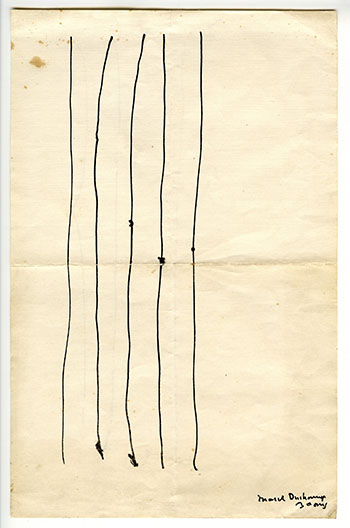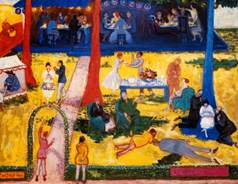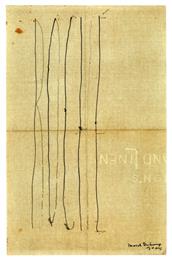


Pen and ink on paper, 8 7/8 x 5 3/4 inches
This drawing was made by Duchamp on July 28, 1917, on the occasion of his 30th birthday (as is acknowledged by the inscription in the lower-right corner). On that date, the Stettheimer sisters—Ettie, Florine and Carrie—invited him to join them for a party in his honor at an estate they rented for the summer in Tarrytown, New York, then a fairly small hamlet overlooking the Hudson River about an hour north of New York City. The party was conceived in the tradition of a true fête champêtre, as it was later aptly described in the diaries of Ettie Stettheimer, the most erudite and educated of the three sisters (she had a PhD in philosophy). “Marcel Duchamp’s party was a great success,” she wrote. “A series of pretty pictures—first tea on the lawn under the maples and some of us ‘sur l’herbe,’ and afterwards three tables on the terrace and Japanese lanterns, blue and green and yellow (alone) strung across Duchamp’s table of painters.” She then went on to list the various guests in attendance: Francis Picabia, Albert Gleizes, Carl van Vechten and Fania Marinoff, Leo Stein, Avery Hopwood and Henri-Pierre Roché. Shortly after the party, Florine, the artist in the family, made a detailed painting of the event, an image that captures for posterity the various festivities that took place on that day in honor of Duchamp (Fig. 1).

Fig. 1 Florine Stettheimer, La Fete a Duchamp, 1917
Oil on canvas, 35 x 45 1/2 inches
Duchamp arrived at the party in Picabia’s speeding automobile (seen waiving to guests in the upper-left corner of the picture). Apparently, shortly after his arrival, one of the Stettheimer sisters (probably Ettie) asked him to prepare place cards for each of the invited guests, and Duchamp drew their names on separate pieces of paper that he carefully folded in half. The names, however, were not immediately discernible; in order to read them, you had to hold the paper up to the light (some of the guests seated at tables in the background of Florine’s painting appear to be doing precisely that), for only then would you discover that Duchamp drew fragments of their names on both sides of the paper, decipherable only when both sides were visible at once. Only three of the place cards survive: those for Marinoff and van Vechten, and one that was recently discovered and presented here made for Henri-Pierre Roché. Roché was an author and art critic, sent to New York on a diplomatic mission during the war. Soon after his arrival, he and Duchamp met and became close friends, a relationship that continued until the end of their lives. The place card that Duchamp made for Roché differed from the others, although it, too, had to be held up to light (Fig. 2). Duchamp spelled out only his friend’s last name with long, attenuated letters, so that in order to be read, the unfolded paper had to be held at an oblique angle to the eyes, in the fashion of an anamorphic projection, reflecting an interest in optics that Duchamp found fascinating since his youth, but which he was then in the process of exploring for its application to other work.

Fig. 2 Roché drawing with light through the paper